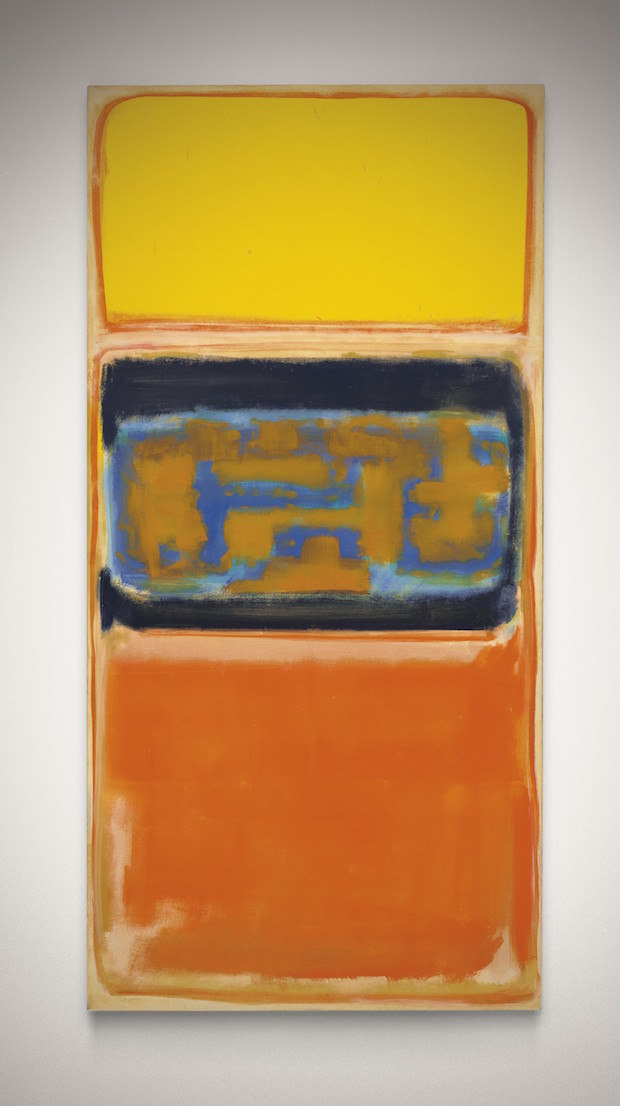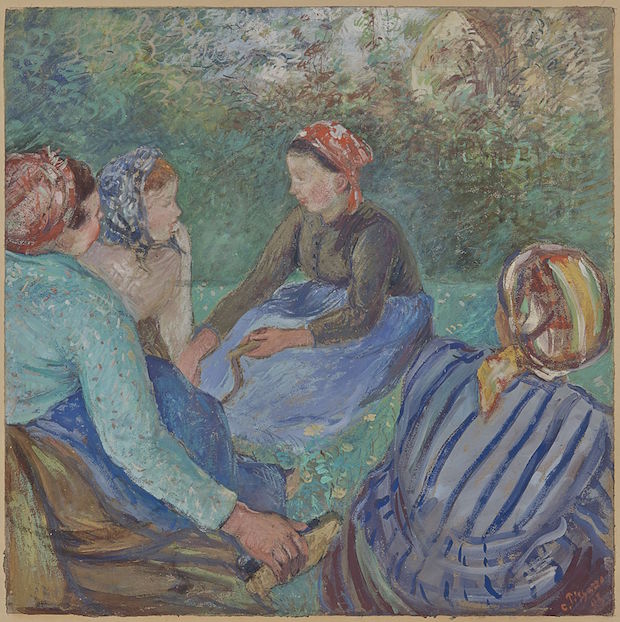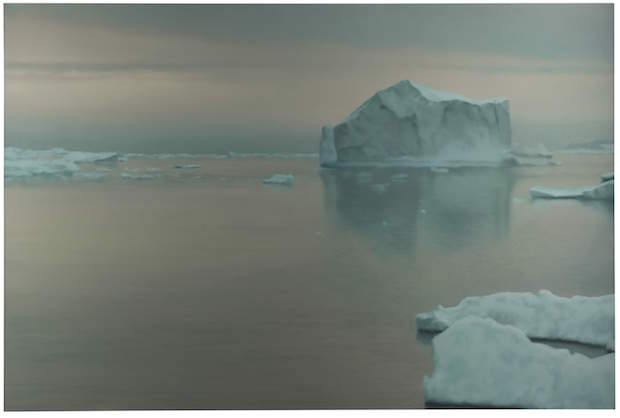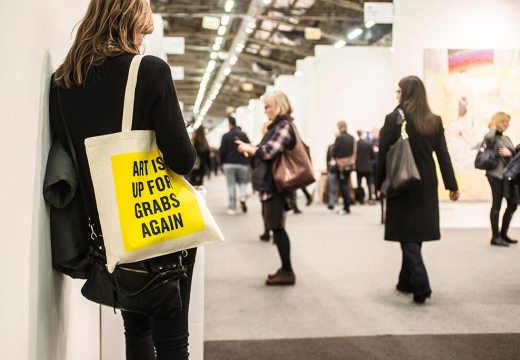Gerhard Richter’s Eisberg belongs to the great tradition of German Romantic painting. It brings to mind not so much Caspar David Friedrich’s The Sea of Ice as the sublime expanses and isolation of his Monk by the Sea. The 19th-century artist was very much in Richter’s thoughts when he set out alone to photograph the desolate icy wastes of Greenland in 1972. The project was, as he is quoted as saying in Dietmar Elger’s biography, ‘an excuse for getting away…Trouble in my marriage was reaching a climax. Going into the ice could be interpreted as longing for a place where one feels safe – just so long as there is no life, only ice.’ He was to return to those photographs after his divorce in 1981, producing three iceberg paintings of which this is the largest.
While there may be no God or spirituality invoked in Richter’s painting, there is a sense of this contemplation of nature as a metaphor for the artist’s state of mind. As he wrote in 1981: ‘Painting is the making of an analogy for something nonvisual and incomprehensible: giving it form and bringing it within reach.’ Like Friedrich’s empathetic monks or pilgrims gazing out towards expansive sea or mountain, we too are drawn into this luminous and mesmerisingly beautiful prospect – and our own reflections.
Eisberg has remained in the same private collection since 1983, the year after it was painted. It now comes to auction at Sotheby’s London’s Contemporary Art evening sale on 8 March with an estimate of £8m–£12m. Five year’s ago, Eis changed hands for £4.3m. The third work in the group is in the Doris and Donald Fisher collection, and is a promised gift to the San Francisco Museum of Modern Art.
If Richter’s work belongs to the modern sublime, Rothko’s belongs to the abstract. One of the earliest of his pioneering ‘multiform’ or Colour Field paintings – vertical canvases of floating bands of vital, luminous colour – makes its first outing at auction at Christie’s London’s Post-War and Contemporary Art sale on 7 March. No. 1 dates from 1949, and was exhibited at Rothko’s breakthrough show at the Betty Parsons Gallery the following year where he hung it against a dark grey wall. The painting remained in the artist’s estate, leaving the family only a decade or so ago. As David Anfam puts it: ‘We gain a greater sense of space and light, looking through that surface as though it concealed depths and veiled radiances.’ Estimate £8m–£12m.

No. 1 (1949), Mark Rothko. Christie’s Images Ltd. (£8m–£12m)
At Christie’s London, too, is one of Robert Rauschenberg’s equally groundbreaking early silkscreen paintings, Transom (1963). In his ‘Note on Painting’ of the same year, the artist commented on his ‘fascination with images…based on the complex interlocking of disparate visual facts…that have no respect for grammar’. Jostling among the ‘visual facts’ of modern urban life here are Velázquez’s Rokeby Venus, water towers, and a Chinook chopper.
It is surprising to find these two canvases heading up a strong group of American works on offer in London rather than in New York (also included in the sale are pieces by Basquiat, Warhol, Carl André, and Sturtevant). Both Rothko and Rauschenberg have taken a starring role in recent exhibitions in the capital – and Tate Modern’s Rauschenberg show is to go on to MoMA. According to the saleroom’s Katharine Arnold, Tate’s retrospective transformed our understanding of the artist, and by devoting a whole gallery to the silkscreens revealed them to be a key body of work. Transom comes to auction with an estimate of £4m–£6m – it failed to sell at auction in 2009 at $4m–$6m, but changed hands thereafter. In light of the Tate show, and the painting’s pre-sale global tour, it is an estimate that looks slight. Unsurprisingly, the weak pound was also cited as part of the allure of London as a selling platform. Both works were consigned from the US.
What is on offer in abundance in New York is Asian art. Christie’s alone is fielding seven sales in its Asian Art Week. Among them are works from two private holdings: those of the late Marie Theresa ‘Bebe’ Virata (16 March) and the Fujita Museum in Osaka. The latter is consigning ‘important’ Chinese pieces on 15 March. Among them is an extremely rare – and dare it be said, endearing? – archaic bronze gong in the form of a ram. This ritual vessel, dating from the late Shang dynasty and the 12th–11th century BC, takes its place among a select menagerie of zoomorphic piece-mould vessels in the form of elephants, oxen, rhinos, buffalo and the like, each ornamented with further bird or animal masks with a taotie motif. Remarkable about this particularly sculptural example is its naturalism, not least the undecorated head, swelling belly and articulated joints of its rear fetlocks. Like other examples, this splendidly horned ram carries smaller creatures on its back, serving as handles on its lid. Standing here is a kui dragon and a bird. Expectations are $6m–$8m.

Paysannes au repos (1883), Camille Pissarro. Christie’s Images Ltd. (€800,000–€1.2m)
In Paris it is drawings week, with fairs Salon du Dessin (22–27 March) and Drawing Now (23–26 March) supplemented by even more activity in the salerooms. Sotheby’s offers its inaugural sale of Dessins Modernes et Contemporains on 23 March. Christie’s series of sales includes groups of drawings consigned by the descendants of both Henri de Toulouse-Lautrec and the brother of Edgar Degas. Among the 55 works on paper in the Atelier Degas offering of 23 March is a pencil study of the artist’s sister, Thérèse (estimate €50,000–€70,000), made for the 1865–66 seated portrait of her and her husband Edmondo Morbilli. From the direct descendants of the great Impressionist dealer Paul Durand-Ruel comes Camille Pissarro’s Paysannes au repos. This large-scale sheet, executed in distemper on paper in 1883, belongs to a group of works depicting young women at their rare moments of rest between their labours in and around Pontoise. Such modern rural scenes were praised by Émile Zola for their ‘ordinary reality’. Estimate €800,000–€1.2m.
From the March 2017 issue of Apollo. Preview and subscribe here.
Unlimited access from just $16 every 3 months
Subscribe to get unlimited and exclusive access to the top art stories, interviews and exhibition reviews.














![Masterpiece [Re]discovery 2022. Photo: Ben Fisher Photography, courtesy of Masterpiece London](http://www.apollo-magazine.com/wp-content/uploads/2022/07/MPL2022_4263.jpg)
It’s time for the government of London to return to its rightful home